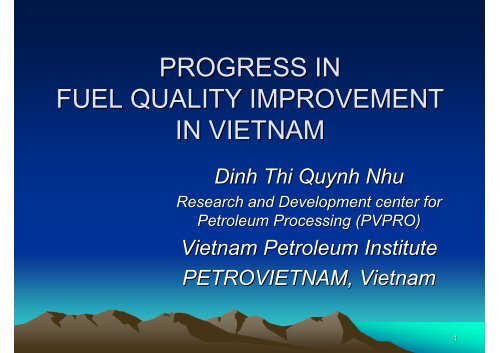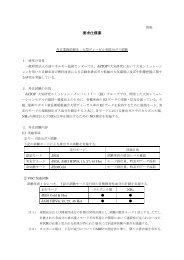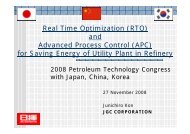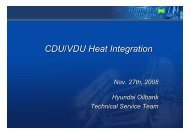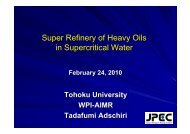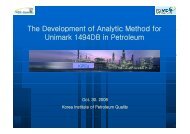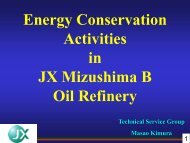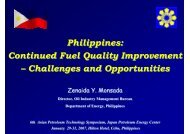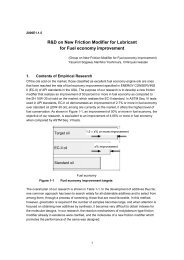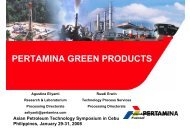PROGRESS IN FUEL QUALITY IMPROVEMENT IN VIETNAM
PROGRESS IN FUEL QUALITY IMPROVEMENT IN VIETNAM
PROGRESS IN FUEL QUALITY IMPROVEMENT IN VIETNAM
You also want an ePaper? Increase the reach of your titles
YUMPU automatically turns print PDFs into web optimized ePapers that Google loves.
<strong>PROGRESS</strong> <strong>IN</strong><br />
<strong>FUEL</strong> <strong>QUALITY</strong> <strong>IMPROVEMENT</strong><br />
<strong>IN</strong> <strong>VIETNAM</strong><br />
Dinh Thi Quynh Nhu<br />
Research and Development center for<br />
Petroleum Processing (PVPRO)<br />
Vietnam Petroleum Institute<br />
PETRO<strong>VIETNAM</strong>, Vietnam<br />
1
1 – <strong>IN</strong>TRODUCTION<br />
• Until now almost fuel products used for<br />
domestic demand in Vietnam are imported,<br />
among those, gasoline and diesel take up high<br />
ratio.<br />
• The exhaust fumes from automobiles using<br />
gasoline and diesel are main source causing<br />
environmental pollution, especially in big cities.<br />
• The Vietnamese government has effort to<br />
minimize the pollution problem.<br />
• One of the solutions for increasing air quality is<br />
improvement of environmental standards and<br />
fuel specifications.<br />
2
2 – CURRENT STATUS<br />
• With GDP growth 7.5% per annual for period 2007-<br />
2020 petroleum fuel consumption will grow up 5%<br />
per annual on average<br />
( gasoline : 11%, diesel : 5%).<br />
• Up to September 2007, there are above 5 millions<br />
motor cycles and 500,000 automobiles in Ha noi and<br />
Ho Chi Minh city.<br />
• Observation results show that 40% of pollutants<br />
emitted from transport.<br />
• It is very difficult to reduce quantity of vehicles in<br />
Vietnam, but using cleaner fuel is one of issues to<br />
protect environment.<br />
3
Forecast of fuel consumption<br />
in Vietnam<br />
1000 ton<br />
16000<br />
14000<br />
12000<br />
10000<br />
8000<br />
6000<br />
4000<br />
2000<br />
0<br />
2007 2010 2015 2020<br />
Year<br />
Gasoline<br />
DO<br />
FO<br />
Kerosene<br />
Jet A1<br />
LPG<br />
4
3 - Goverment regulations and<br />
emission standards<br />
• On January 10th, 1994 the Law on Environmental<br />
Protection of Vietnam went into effect<br />
• In 1995 a set of environmental standards were<br />
issued by the MOSTE and were revised in 2005.<br />
Some standards related to the emission from fuel<br />
combustion are listed hereunder:<br />
– TCVN-5938-1995 (Air quality- ambient air quality<br />
standards)<br />
– TCVN-6438-1998 ( Road vehicle – Maximum<br />
permitted limits of exhaust gases ).<br />
– TCVN-6431-1998: Road vehicles – Gaseous<br />
pollutants emitted from automobiles and<br />
motorcycles equipped with gasoline engines –<br />
Emission requirements in type approval test.<br />
5
Maximum permitted limits of pollutant<br />
compounds in exhaust gases<br />
Pollutant<br />
compounds in<br />
exhaust gases<br />
Vehicle with forced combustion’s<br />
engine<br />
Automobiles<br />
Motobiles<br />
Vehicle with<br />
compressed<br />
combustion’s engine<br />
Level<br />
1<br />
Level<br />
2<br />
Level<br />
3<br />
Level<br />
1<br />
Level<br />
2<br />
Level<br />
1<br />
Level<br />
2<br />
Level<br />
3<br />
CO ( % Vol,)<br />
4.5<br />
3.5<br />
3.0<br />
4.5<br />
-<br />
-<br />
-<br />
HC ( Vppm )<br />
Four-cycle<br />
engine<br />
1200<br />
800<br />
600<br />
1500<br />
1200<br />
-<br />
-<br />
-<br />
Two-cycle<br />
engine<br />
7800<br />
7800<br />
7800<br />
10000<br />
78000<br />
-<br />
-<br />
-<br />
Special engine<br />
3300<br />
3300<br />
3300<br />
-<br />
-<br />
-<br />
Fume<br />
( % HSU )<br />
-<br />
-<br />
-<br />
-<br />
-<br />
72<br />
60<br />
50<br />
6
4 – PROPERTIES OF <strong>FUEL</strong> <strong>IN</strong>FLUENC<strong>IN</strong>G<br />
THE ENVIRONMENT<br />
• To reduce an air pollution, we have to minimize<br />
exhaust gas of engine, essentially to reduce<br />
emission CO, NOx, SO2, Hydrocarbon, particulate<br />
matter, …<br />
• Main properties of gasoline affecting exhaust gas<br />
quality are aromatics content, olefin, benzene,<br />
oxygenate, Reid Vapour Presssure, lead, another<br />
Octane additives.<br />
• Some properties of diesel affecting exhaust gas<br />
quality are sulfur content, distillation, flash point,<br />
polyaromatics content.<br />
7
Properties of gasoline<br />
influencing the environment<br />
No.<br />
1<br />
2<br />
3<br />
Properties and role<br />
Aromatics :<br />
compounds have high<br />
octane number<br />
Olefin: compounds<br />
have high octane<br />
number, performed in<br />
cracking process<br />
Benzene: compound<br />
have high octane<br />
number<br />
Influence<br />
Cause deposit in engine,<br />
increase emission NO x<br />
and<br />
particulate. Decreasing<br />
aromatic content and T90 can<br />
decrease carbon soot and CO<br />
in exhaust gas<br />
Cause gum in storage,<br />
deposit in engine, its high<br />
evaporation causes air<br />
pollution<br />
Cancerigenic compound.<br />
Its high evaporation causes<br />
air pollution<br />
8
Properties of gasoline<br />
influencing the environment<br />
No.<br />
4<br />
Properties and role<br />
Oxygenate compound:<br />
have high octane number,<br />
replace lead additive,<br />
aromatic. Allowable<br />
Maximum oxygen content<br />
is 2.7%<br />
MTBE: 10-15% Vol.<br />
Etanol: From 3-10% Vol.<br />
Influence<br />
MTBE: increase clean combustion<br />
ability, reduce emission NOx, CO,<br />
HC in exhaust gas of engine.<br />
When it leaks out to environment, it<br />
can cause ground water pollution<br />
( water have pungent even at very<br />
low MTBE content )<br />
Etanol: reduce emission CO, NO x<br />
in<br />
exhaust gas<br />
When blend much (more than<br />
10%Vol.) it can increase emission<br />
NO x<br />
, volatility.<br />
Etanol can increase corrosion in<br />
storage tank because of water<br />
absorption capacity<br />
9
Properties of gasoline<br />
influencing the environment<br />
No.<br />
5<br />
6<br />
Properties and role<br />
Reid Vapour<br />
Pressure (RVP)<br />
It must be enough<br />
low to decrease<br />
volatility, and<br />
enough high to start<br />
up safely<br />
Lead additive:<br />
increase octane<br />
number.<br />
Influence<br />
If RVP is too high , it will<br />
increase volatility (in<br />
product distribution<br />
process, from car gasoline<br />
container ), cause<br />
environmental pollution.<br />
Lead Emission in exhaust<br />
gas is very hamful for the<br />
environment and people.<br />
Vietnam eliminated leaded<br />
gasoline.<br />
10
Properties of gasoline<br />
influencing the environment<br />
No.<br />
7<br />
8<br />
Properties and role<br />
MMT (Methyl<br />
ciclopentadienyl<br />
manganese tricarbonyl) is<br />
octane metalorganic<br />
additive. It is used to<br />
replace lead additive<br />
Sulfur content<br />
Influence<br />
MMT increase octane number.<br />
It can decrease exhaust gas,<br />
environmental pollution.<br />
When blend much, it can<br />
increase deposit in engine<br />
and influence catalytic<br />
converter<br />
High sulfur content in<br />
gasoline influences air quality<br />
(SO 2<br />
emission).<br />
Sulfur decreases operating<br />
ability of catalytic converter<br />
11
Properties of diesel influencing<br />
the environment<br />
No.<br />
1<br />
2<br />
Properties and<br />
role<br />
Sulfur<br />
Distillation:<br />
Temperature of<br />
90% recovered<br />
Influence<br />
High sulfur content in<br />
diesel influences air<br />
quality (SO 2<br />
emission)<br />
High temperature of<br />
90% recovered<br />
increases emission<br />
NO x<br />
, Particulate matter<br />
12
Properties of diesel influencing<br />
the environment<br />
No.<br />
Properties and role<br />
Influence<br />
3<br />
4<br />
Flash point<br />
Poly Aromatics<br />
Low flash point<br />
increases volatility in<br />
storage and use ( CH<br />
emission)<br />
Cause deposit in<br />
engine, increase<br />
emission NO x<br />
and<br />
particulate.<br />
13
EUROPEAN GASOL<strong>IN</strong>E SPECIPICATION<br />
PROPERTIES<br />
Euro II<br />
Euro III<br />
Euro IV<br />
Euro V<br />
Aromatics content, %Vol<br />
-<br />
42<br />
35<br />
35<br />
Olefin content, % Vol.<br />
-<br />
18<br />
18<br />
18<br />
Benzene content, % Vol.<br />
5.0<br />
1.0<br />
1.0<br />
1.0<br />
Oxygen content, % Wt.<br />
-<br />
2.7<br />
2.7<br />
2.7<br />
Sulfur content, ppm<br />
1000/500<br />
150<br />
50<br />
10<br />
Reid Vapour Pressure,<br />
kPa<br />
35-100<br />
60/70<br />
45-100<br />
45-100<br />
Lead content, g/L<br />
0,013<br />
Nil<br />
Nil<br />
Nil<br />
14
EUROPEAN DIESEL SPECIFICATION<br />
PROPERTIES<br />
Euro II<br />
Euro III<br />
Euro IV<br />
Euro V<br />
Poly<br />
Aromatics, %Vol<br />
N/A<br />
11.0<br />
11.0<br />
6.0<br />
Sulfur, ppm<br />
2000/500<br />
350<br />
50<br />
10<br />
51<br />
Cetane number 46-49 51 51<br />
kg/m 3<br />
Density @ 15 0 C, 820-860 820-845 820-845 820-845<br />
Distillation, T95, 0 C<br />
370<br />
360<br />
360<br />
360<br />
15
5 - Upgrading process of fuel<br />
specifications<br />
No<br />
Fuel<br />
spec.<br />
TCVN<br />
Leaded<br />
Gasoline<br />
Unleaded<br />
gasoline<br />
Kerosene<br />
Jet fuel<br />
D.O<br />
F.O<br />
1<br />
1992<br />
5690-1992<br />
5689-1992<br />
2<br />
1997<br />
6240:1997<br />
5689-1997<br />
6239-1997<br />
3<br />
1998<br />
5690-1998<br />
6426-1998<br />
4<br />
2000<br />
6776-2000<br />
5<br />
2001<br />
6<br />
2002<br />
7208:2002<br />
hazard<br />
ous<br />
materia<br />
l in<br />
gasolin<br />
es<br />
6240:2002<br />
6426-2002<br />
5689-2002<br />
6239-2002<br />
7<br />
2005<br />
6776-2005<br />
6426-2005<br />
5689-2005<br />
8<br />
2007<br />
6426-2007<br />
16
Improvement in Gasoline specification and<br />
forecast<br />
No<br />
Characteristics<br />
Leaded Gasolines<br />
1992 1998<br />
2000<br />
Unleaded Gasolines<br />
2002<br />
2005<br />
Forecast in<br />
period<br />
2007-<br />
2015<br />
1<br />
Octan No.<br />
RON, min<br />
83 92 97<br />
83 92 97<br />
90 92 95<br />
-<br />
90 92 95<br />
92 95 97<br />
2<br />
Lead g/L, max.<br />
0.4<br />
0.15<br />
0,013<br />
0.013<br />
0.013<br />
< 0.01<br />
3<br />
Aromatic % Vol.<br />
max.<br />
-<br />
-<br />
-<br />
40<br />
40<br />
30<br />
4<br />
Sulphur %Wt.<br />
max.<br />
0.15<br />
0.15<br />
0.15<br />
0.15<br />
0.05<br />
0.02<br />
5<br />
Benzene % Vol.<br />
Max.<br />
-<br />
-<br />
5<br />
5<br />
2.5<br />
< 2.0<br />
6<br />
RVP, kPa, max.<br />
70 75<br />
43-80<br />
43-80<br />
-<br />
43-75<br />
43-75<br />
7<br />
MTBE, % vol.<br />
Max.<br />
-<br />
-<br />
-<br />
10<br />
-<br />
-<br />
8<br />
Olefin, %Vol., max<br />
-<br />
-<br />
-<br />
-<br />
38<br />
< 20<br />
9<br />
Oxygen, %Wt.,<br />
max<br />
-<br />
-<br />
-<br />
-<br />
2.7<br />
2.0<br />
10<br />
T90%, 0 C, max<br />
-<br />
190<br />
190<br />
-<br />
190<br />
180<br />
17
Improvement in Diesel specification<br />
and forecast<br />
No<br />
Characteristics<br />
1992<br />
1997<br />
2002<br />
2005<br />
Forecast in<br />
period<br />
2007-<br />
2015<br />
1<br />
Cetan Number,<br />
min.<br />
45<br />
50 45<br />
45<br />
46<br />
48-55<br />
2<br />
Sulphur Wt%.<br />
max.<br />
1.0<br />
0.5 1.0<br />
0.05 0.25 0.5<br />
0.05 0.25<br />
0.05 0.1<br />
3<br />
90% recovered,<br />
0<br />
C, max<br />
370<br />
370<br />
370<br />
360<br />
360<br />
4<br />
Flash point, 0 C,<br />
min<br />
-<br />
60 50<br />
50<br />
55<br />
65<br />
5<br />
Density @<br />
15 0 C, kg/m 3<br />
-<br />
-<br />
-<br />
820-860<br />
840-860<br />
18
For automotive gasoline:<br />
• The gasoline with RON 83 has been<br />
eliminated from the year of 2000.<br />
• The leaded gasolines have been<br />
eliminated from July 1st 2001 without<br />
phasedown.<br />
• The benzene content has been<br />
controlled from 2000.<br />
• The aromatic content, MTBE have been<br />
controlled from 2002.<br />
19
For auto-diesel:<br />
• Sulfur content decreases from<br />
spec. to spec.<br />
• Temperature of 90% recovered<br />
decreases to 360oC ( 2005 ).<br />
20
6 - TECHNOLOGICAL ISSUES<br />
IMPROV<strong>IN</strong>G <strong>FUEL</strong> <strong>QUALITY</strong><br />
• PetroVietnam is in the process of building<br />
the first refinery Dung Quat and will<br />
construct 2 - 3 refineries to meet domestic<br />
consumption and export to other countries in<br />
the region.<br />
• Specifications of fuel quality and their<br />
forecast are the basics for selecting<br />
technologies, crude oil and calculating<br />
economic effect, investments, upgrading the<br />
refineries.<br />
21
The first refinery Dung quat<br />
• Location: Dung quat, Quang ngai province;<br />
• Capacity : 6.5 million tons per annual.<br />
• Feed stock: At first period 100% Vietnamese<br />
crude oil is refined, then refined crude oil mix<br />
Bach Ho / Dubai = 85/15.<br />
• Technologies: applying the deeply refined<br />
and modern technologies.<br />
• Fuel products: LPG, unleaded gasoline,<br />
kerosene, Jet fuel, Auto-diesel, fuel oil.<br />
• Fuel spec. are equivalent to EURO II.<br />
• Refinery will operate in 2009.<br />
22
Figure 1: Technological scheme of base case<br />
of first refinery.<br />
23
Technologies concerning improvement<br />
of fuel quality<br />
• Continious Catalytic Reformer ( CCR ) :<br />
• Residue Fluidised Catalytic Cracker<br />
(RFCC):<br />
• Isomerization unit:<br />
• LCO hydrotreating unit :<br />
• Kerosene treater, RFCC naphtha treater:<br />
• LPG treater :<br />
• Naphtha hydrotreater:<br />
24
Second refinery Nghi Son<br />
• Location: Nghi Son, Thanh Hoa province;<br />
• Capacity : 7.0 million tons per annual;<br />
• Feed stock: Black Lion and Middle-east<br />
crude oil ( Light Iran, light Arabian, Dubai ).<br />
• Technologies: applying the deeply refined<br />
and modern technologies.<br />
• Fuel products: LPG, unleaded gasoline<br />
(RON 92,95,98), kerosene, Jet fuel, Autodiesel,<br />
fuel oil.<br />
• Fuel spec. are equivalent to EURO III/IV<br />
• Refinery will operate in 2013.<br />
25
Figure 2 : Optimum technological<br />
scheme of second refinery<br />
26
Technologies concerning improvement<br />
of fuel quality<br />
• Continious Catalytic Reformer ( CCR ) ;<br />
• Residue Fluidised Catalytic Cracker<br />
(RFCC);<br />
• Isomerization unit;<br />
• Kerosene hydrotreating unit, Naphtha<br />
hydrotreater, Gasoil hydrodesulfurization,<br />
Residue hydrodesulfurization.<br />
27
Third refinery Long Son<br />
• Location: Long Son, Baria-Vung tau<br />
province;<br />
• Capacity : 10 million tons per annual ;<br />
• Feed stock: Venezuela crude oil 16oAPI,<br />
25oAPI, 32oAPI ;<br />
• Technologies: applying the deeply refined<br />
and modern technologies;<br />
• Fuel products: LPG, naphtha, gasoline, Jet<br />
fuel, diesel, ref. fuel , coke.<br />
• Fuel spec. are equivalent to EURO IV/V;<br />
• Refinery will operate in 2013.<br />
28
Figure 3: Technological scheme of base<br />
case of third Refinery<br />
29
Technologies concerning<br />
improvement of fuel quality :<br />
• Continious Catalytic Reformer ( CCR ) ;<br />
• Fluidised Catalytic Cracker (FCC):<br />
• Hydrocracking ( HCK )<br />
• Isomerization unit;<br />
• Delayed coking (DC);<br />
• Kerosene hydrotreating unit, Naphtha<br />
hydrotreater, Gasoil<br />
hydrodesulfurization.<br />
30
7 - BIO<strong>FUEL</strong> DEVELOPMENT<br />
Recently, The Vietnamese Prime<br />
Minister has approved “Biofuel<br />
development project to 2015 and<br />
tendency to 2025” with the main target<br />
of developing biofuel, a new kind of<br />
regenerable energy, which can replace<br />
in part the traditional fossil fuel, to<br />
ensure energy security and to protect<br />
environment.<br />
31
7 - BIO<strong>FUEL</strong> DEVELOPMENT<br />
1 – Period 2006-2010: Viet Nam will approach<br />
technology producing biofuel, build a pilot model of<br />
biofuel distribution in some cities and provinces,<br />
plan plant of raw material trees and educate high<br />
qualification staff.<br />
2 – Period 2011 – 2015: will develop production of<br />
biofuel and use biofuel to replace in part the<br />
traditional fossil fuel, to reach capacity of etanol and<br />
vegetal oil 250,000 tons to supply 1% of domestic<br />
demand of fuel.<br />
3 – To 2025: Technology of biofuel will reach world<br />
advantage with capacity of etanol and vegetal oil 1.8<br />
million ton to supply about 5% of domestic demand<br />
of fuel.<br />
32
8 - COMMENTS<br />
• To protect an environment, Vietnamese<br />
government issued a set of emission<br />
standards and fuel specifications and are in<br />
process of its improvement.<br />
• Refineries in Vietnam will produce fuel<br />
products with proper specifications and<br />
apply modern technologies to satisfy fuel<br />
quality requirement.<br />
• To reduce pollution and improve fuel quality<br />
Vietnam has approved “ Biofuel development<br />
project to 2015 and tendency to 2025 ”.<br />
33
THANK YOU FOR ATTENTION<br />
34


